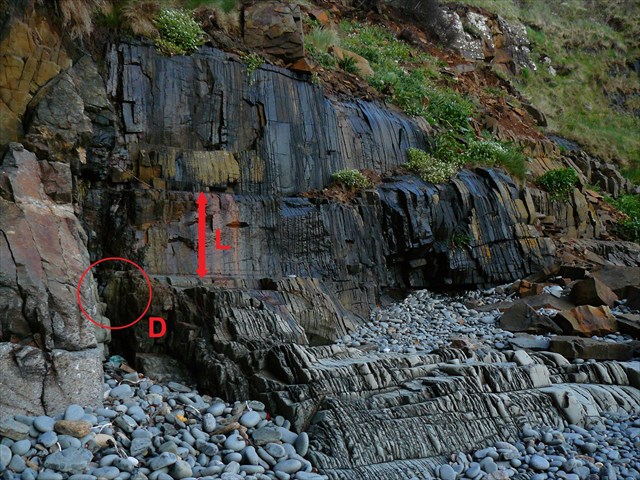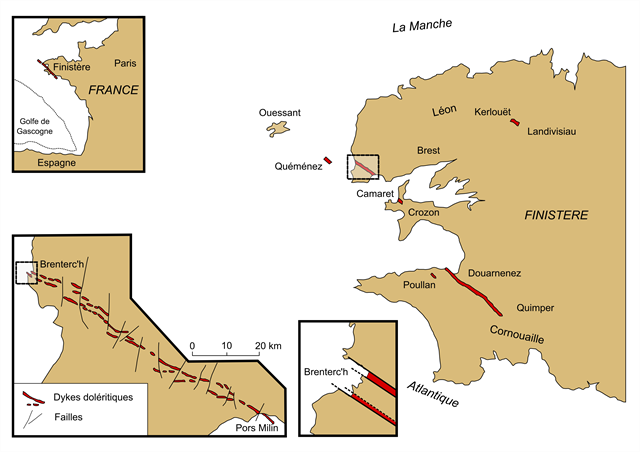Le dyke de Brenterc'h EarthCache
-
Difficulty:
-

-
Terrain:
-

Size:  (other)
(other)
Please note Use of geocaching.com services is subject to the terms and conditions
in our disclaimer.
La grève de Brenterc'h est une petite crique encaissée et exposée aux furies de la mer d'Iroise, dont l'accès est totalement impossible à marée haute. Au fond de cette grève, on trouve une roche sombre, lourde et dure qui m'a toujours intrigué, ne correspondant à rien de ce que je connaissais en Bretagne. Adolescent, j'en avais apporté un échantillon à mon professeur de science naturelle qui fût bien incapable de l'identifier. Ce n'est que récemment, poussé par ma curiosité, que j'ai découvert qu'il s'agissait d'un dyke de dolérite.
The Brenterc'h strike is a small cove steep and exposed to the fury of the Iroise's sea , access to which is completely impossible at high tide. At the back of the strike , there is a dark rock , heavy and hard that has always intrigued me , do not correspond to anything that I knew in Little Brittain. Teenager , I was bringing a sample to my teacher of natural science that was quite unable to identify it. Only recently , driven by my curiosity , I discovered that it was a dolerite dyke.

WP Earth – Vue partielle du dyke
Un dyke ou dike est un filon de roche magmatique qui s'est infiltré dans une fracturation de l'encaissant. De ce fait, un dyke recoupe les autres roches qu'il traverse. Le dyke est un phénomène intrusif dans une fissure d'ouverture transversale. Selon les principes de la stratigraphie, son âge est donc toujours plus jeune que celui des roches encaissantes.
A dyke or dike is an igneous rock vein that has infiltrated into a fracturing of the rock. Therefore, a dike intersects the other rocks it crosses. The dyke is an intrusive phenomenon in a transverse opening crack. According to the principles of stratigraphy , age is still younger than the surrounding rocks .

Champ doléritique de l'ouest du massif armoricain
Le dyke de Brenterc'h est composé de dolérite, roche magmatique à grain moyen issu de la cristallisation d'un magma basique. Ce filon, qui affleure en continu sur l’estran, n’est pas un cas isolé puisque d'autres dykes contemporains affleurent en Finistère. Ce champ doléritique est daté entre 170 et 185 Ma et s'est mis en place lors de l’ouverture de l’océan Atlantique !
The dyke Brenterc'h consists of dolerite , igneous rock medium grain from the crystallization of a basic magma. This vein , which outcrops continuously on the foreshore , is not an isolated case since other contemporary dykes outcrop in Finistère . This doleritic field dated between 170 and 185 Ma and was established at the opening of the Atlantic Ocean !

Pour accéder à la grève puis au dyke, pour votre propre sécurité, emprunter impérativement le chemin d'accès indiqué. Je rappelle par ailleurs que le dyke est inaccessible à marée haute ( voir annuaire des marées ici ).
Pour pouvoir loguer "Found It", rendez-vous aux coordonnées indiquées puis répondez aux questions suivantes dont vous m'adresserez les réponses soit via mon profil, soit via la messagerie geocaching.com :
Question n°1: Quelle est la largeur approximative du dyke?
Question n°2: Quelle est la hauteur de la marche L ( voir photo présentation )?
Question n°3: Quel est le diamètre du carottage que vous trouverez en D ( voir photo présentation )?
Question n°4: Quelle est la particularité des fractures que vous observez dans ce dyke ?
Question n°5: Quelle est la nature de la quasi-totalité des galets au niveau du dyke?
Question n°6: Pouvez-vous expliquer sommairement leur formation ?
To access the strike and the dyke , for your own safety , imperatively take the path specified .The dyke is inaccessible at high tide ( tide tables see here).
To log " Found It ", move to the waypoint coordinate and then answer the following questions which you will address me the answers by my profile or by Message Center geocaching.com :
Question n°1: What is the approximate width of the dyke ?
Question n°2: What is the height of the step L (see photo presentation) ?
Question n°3: What is the diameter of the core that you find D (see photo presentation) ?
Question n°4: What is special fractures you see in the dike ?
Question n°5: What is the nature of almost all of the rollers at the dyke ?
Question n°6: Can you briefly explain their training?
|


Additional Hints
(No hints available.)